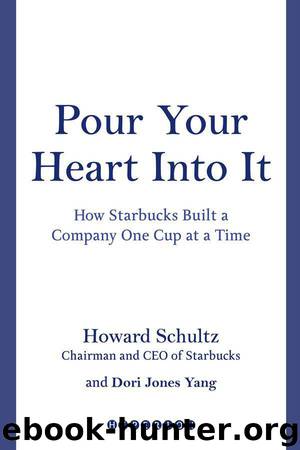Pour Your Heart Into It: How Starbucks Built a Company One Cup at a Time by Schultz Howard

Author:Schultz, Howard [Schultz, Howard]
Language: eng
Format: mobi
Publisher: Hyperion
Published: 2012-05-21T16:00:00+00:00
DON’T GET DIZZY ON WALL STREET’S
EMOTIONAL ROLLER COASTER
If I had to pick the happiest day of my business career, it would have to be June 26, 1992. That was the date we went public, when Starbucks stock was listed on NASDAQ.
Our target range was $14 to $16 per share, a figure considered high at more than sixty times the previous year’s earnings. Some worried about whether we could sustain that high a price, since the market for IPOs, hot in March, suddenly went soft, and most new issues started selling at prices below projections. Our advisers recommended the low end of that range. Local newspaper articles warned small investors to be wary of buying our stock since prices of most new issues drop after the initial offering. Once again, we defied conventional wisdom. We priced Starbucks stock at $17 a share, just above the initial range.
On the big day, several of us in the senior management team went to a brokerage office in downtown Seattle and huddled around a terminal, watching as the name SBUX came up on the screen, open for trading. At the opening bell, the stock price immediately jumped to $21. We cheered.
Starbucks was the second most active stock traded on NASDAQ that day. The IPO raised $29 million for the company, $5 million more than we had expected. By the closing bell, Starbucks’ market capitalization stood at $273 million—just five years after I bought it for slightly under $4 million.
The IPO was one of the most successful of the year—one that made Wall Street brokers search eagerly for “the next Starbucks.” Our share price maintained its strength far longer than Wall Street pundits had predicted. It never fell significantly below the opening price, and within three months, it reached as high as $33 a share, making Starbucks worth nearly $420 million.
Being a public company has lent Starbucks a certain patina, taking it to the big leagues. Our stock market listing provided the liquidity that has allowed many people at Starbucks, including me, to cash in stock options and buy things we need or have long wished for. It has likewise served as a great incentive to attract talented people, who join us not only because of the excitement of building a fast-growing company but also because of the value we are creating.
Our success on Wall Street also added dimension to the brand. It allowed us to go back to the market almost every year and ask investors for more money to underwrite our growth. We’ve raised close to $500 million since going public, by issuing new stock or selling bonds that convert into stock if the price goes above a certain level. I personally enjoy the intellectual stimulation of interacting with the bright people I’ve met on Wall Street, people who have done their homework and understand the company. I also like the challenge of formulating a strategy for Starbucks to finance its growth.
But becoming a public company has its downside, too. It exposes your business to a high degree of scrutiny and your personal life to a sudden lack of privacy.
Download
This site does not store any files on its server. We only index and link to content provided by other sites. Please contact the content providers to delete copyright contents if any and email us, we'll remove relevant links or contents immediately.
| Biographies | Company Profiles |
| Economic History |
Pale Blue Dot by Carl Sagan(4027)
The Rules Do Not Apply by Ariel Levy(3924)
Goodbye Paradise(2989)
Delivering Happiness by Tony Hsieh(2932)
Liar's Poker by Michael Lewis(2826)
Into Thin Air by Jon Krakauer(2718)
Purple Cow by Seth Godin(2711)
Ogilvy on Advertising by David Ogilvy(2703)
Rogue Trader by Leeson Nick(2484)
The Airbnb Story by Leigh Gallagher(2383)
The Social Psychology of Inequality by Unknown(2324)
The Mind Map Book by Tony Buzan(2096)
Six Billion Shoppers by Porter Erisman(2005)
Bossypants by Tina Fey(2003)
Claridge's: The Cookbook by Nail Martyn & Erickson Meredith(1974)
All the President's Men by Carl Bernstein & Bob Woodward(1968)
Master of the Game by Sidney Sheldon(1894)
Alibaba by Duncan Clark(1760)
Wild Ride by Adam Lashinsky(1662)
